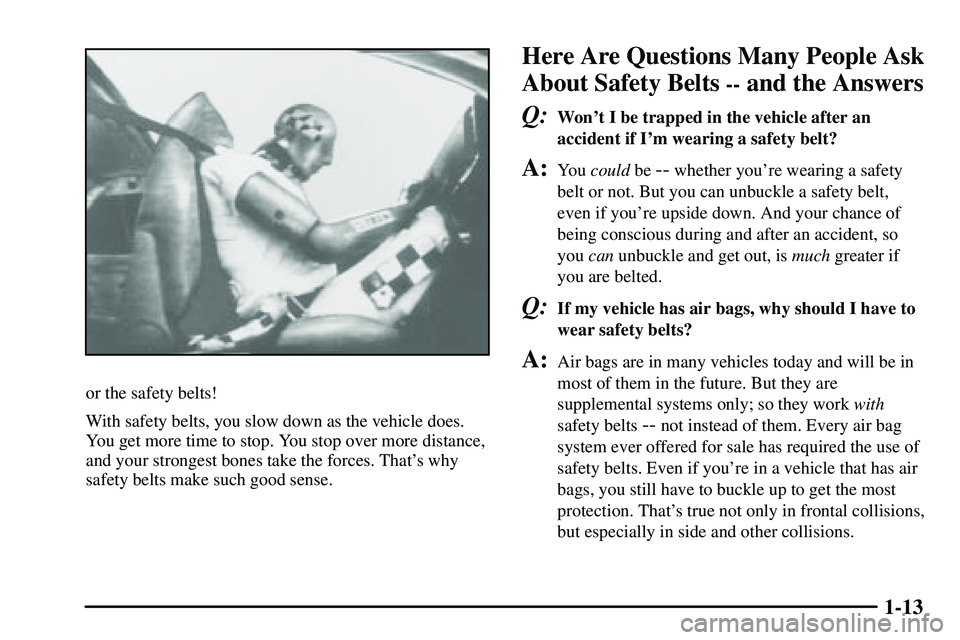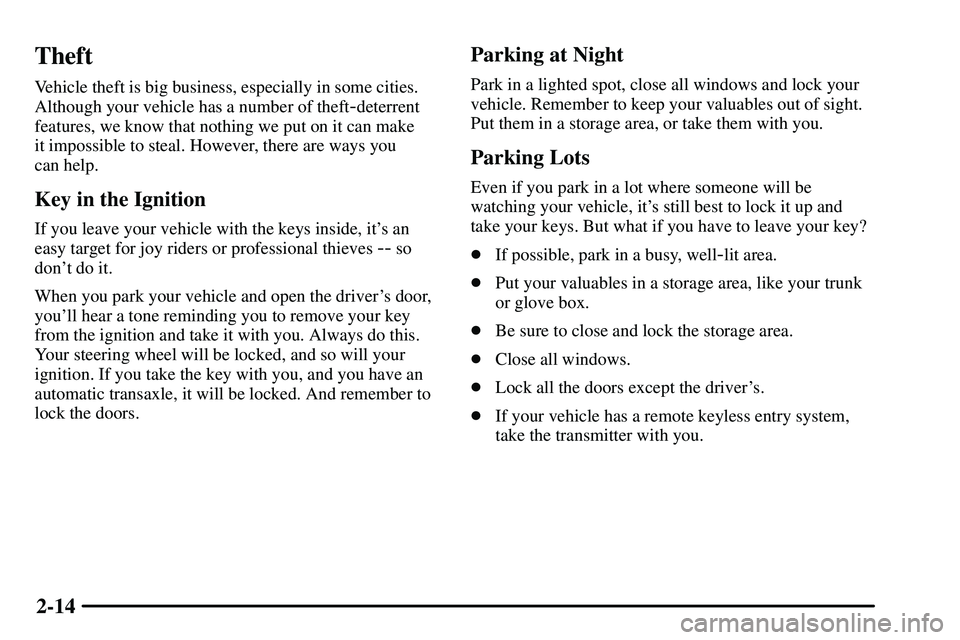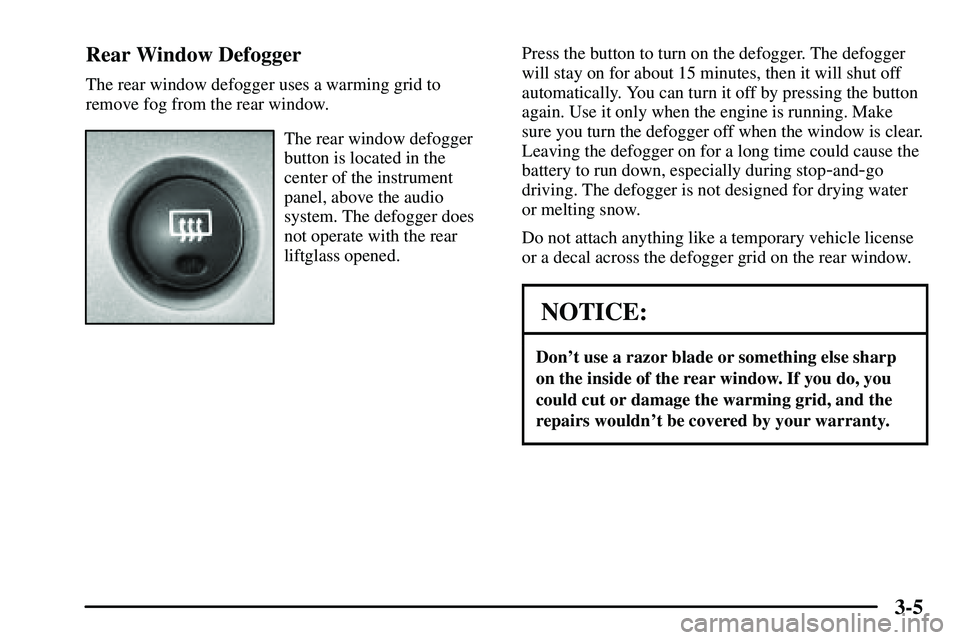Page 19 of 381

1-13
or the safety belts!
With safety belts, you slow down as the vehicle does.
You get more time to stop. You stop over more distance,
and your strongest bones take the forces. That's why
safety belts make such good sense.
Here Are Questions Many People Ask
About Safety Belts
-- and the Answers
Q:
Won't I be trapped in the vehicle after an
accident if I'm wearing a safety belt?
A:You could be -- whether you're wearing a safety
belt or not. But you can unbuckle a safety belt,
even if you're upside down. And your chance of
being conscious during and after an accident, so
you can unbuckle and get out, is much greater if
you are belted.
Q:If my vehicle has air bags, why should I have to
wear safety belts?
A:Air bags are in many vehicles today and will be in
most of them in the future. But they are
supplemental systems only; so they work with
safety belts
-- not instead of them. Every air bag
system ever offered for sale has required the use of
safety belts. Even if you're in a vehicle that has air
bags, you still have to buckle up to get the most
protection. That's true not only in frontal collisions,
but especially in side and other collisions.
Page 50 of 381
1-44
Anchor the top strap to one of the top strap anchors.
Your vehicle has top strap anchors for the rear seating
positions. You will find three top strap anchors in a
covered compartment on the floor of the rear cargo area.
To access the anchors, open the compartment doors
marked with the child restraint anchor symbol. Choose
the anchor that corresponds to the seating position where
the child restraint will be placed. Raise the head restraint
and route the top strap under it.
Once you have the top strap anchored, you'll be ready to
secure the child restraint itself. Tighten the top strap
when and as the child restraint manufacturer's
instructions say.
Page 66 of 381
2-2
Windows
CAUTION:
Leaving children in a vehicle with the windows
closed is dangerous. A child can be overcome by
the extreme heat and can suffer permanent
injuries or even death from heat stroke. Never
leave a child alone in a vehicle, especially with the
windows closed in warm or hot weather.
Page 70 of 381
2-6
Door Locks
CAUTION:
Unlocked doors can be dangerous.
�Passengers -- especially children -- can
easily open the doors and fall out of a
moving vehicle. When a door is locked, the
handle won't open it. You increase the
chance of being thrown out of the vehicle in
a crash if the doors aren't locked. So, wear
safety belts properly and lock the doors
whenever you drive.
�Young children who get into unlocked
vehicles may be unable to get out. A child
can be overcome by extreme heat and can
suffer permanent injuries or even death
from heat stroke. Always lock your vehicle
whenever you leave it.
�Outsiders can easily enter through an
unlocked door when you slow down or stop
your vehicle. Locking your doors can help
prevent this from happening.
There are several ways to lock and unlock your vehicle.
From the outside, use your key or the remote keyless
entry transmitter, if equipped. See ªRemote Keyless
Entryº in the Index for more information.
Page 78 of 381

2-14
Theft
Vehicle theft is big business, especially in some cities.
Although your vehicle has a number of theft
-deterrent
features, we know that nothing we put on it can make
it impossible to steal. However, there are ways you
can help.
Key in the Ignition
If you leave your vehicle with the keys inside, it's an
easy target for joy riders or professional thieves
-- so
don't do it.
When you park your vehicle and open the driver's door,
you'll hear a tone reminding you to remove your key
from the ignition and take it with you. Always do this.
Your steering wheel will be locked, and so will your
ignition. If you take the key with you, and you have an
automatic transaxle, it will be locked. And remember to
lock the doors.
Parking at Night
Park in a lighted spot, close all windows and lock your
vehicle. Remember to keep your valuables out of sight.
Put them in a storage area, or take them with you.
Parking Lots
Even if you park in a lot where someone will be
watching your vehicle, it's still best to lock it up and
take your keys. But what if you have to leave your key?
�If possible, park in a busy, well
-lit area.
�Put your valuables in a storage area, like your trunk
or glove box.
�Be sure to close and lock the storage area.
�Close all windows.
�Lock all the doors except the driver's.
�If your vehicle has a remote keyless entry system,
take the transmitter with you.
Page 107 of 381

2-43 Automatic Light Control (ALC)
Your vehicle is equipped with an automatic light sensor
on the top left corner of the instrument panel, so be
sure it is not covered or the headlamps will be on
continuously.
When it is dark enough outside, your ALC will turn on
your low
-beam headlamps at the normal brightness
along with other lamps such as the taillamps,
sidemarker, parking lamps and instrument panel lights.
The parking brake must be released for ALC to work.
This is indicated by the headlamp symbol on your
instrument panel cluster.
If you are driving through a parking garage, overcast
weather, or a tunnel, the ALC may turn on your
low
-beam headlamps at a normal brightness along with
the taillamps, sidemarker, parking lamps and the
instrument panel lights. The radio lights will be dimmer,
and the instrument panel cluster lights may dim. There
will be a 10 to 15 second delay before the lights will
turn on when starting the car at night.
Lamps On Reminder
If you turn the ignition to LOCK or ACC and leave
the lamps on, you'll hear a tone when you open the
driver's door.
Daytime Running Lamps
Daytime Running Lamps (DRL) can make it easier for
others to see the front of your vehicle during the day.
DRL can be helpful in many different driving
conditions, but they can be especially helpful in the
short periods after dawn and before sunset. Fully
functional daytime running lamps are required on all
vehicles first sold in Canada.
The DRL system will make your headlamps come
on at a reduced brightness when the following
conditions are met:
�The ignition is on with the engine running,
�the exterior lamps switch is off and
�the parking brake is released.
When the DRL are on, only your headlamps will be on
at a reduced brightness. The taillamps, sidemarker and
other lamps won't be on. Your instrument panel won't
be lit up either.
When you turn the exterior lamp switch to the headlamp
position, your DRL will go off and your headlamps will
come on. The other lamps that come on with your
headlamps will also come on.
Page 145 of 381

3-5 Rear Window Defogger
The rear window defogger uses a warming grid to
remove fog from the rear window.
The rear window defogger
button is located in the
center of the instrument
panel, above the audio
system. The defogger does
not operate with the rear
liftglass opened.Press the button to turn on the defogger. The defogger
will stay on for about 15 minutes, then it will shut off
automatically. You can turn it off by pressing the button
again. Use it only when the engine is running. Make
sure you turn the defogger off when the window is clear.
Leaving the defogger on for a long time could cause the
battery to run down, especially during stop
-and-go
driving. The defogger is not designed for drying water
or melting snow.
Do not attach anything like a temporary vehicle license
or a decal across the defogger grid on the rear window.
NOTICE:
Don't use a razor blade or something else sharp
on the inside of the rear window. If you do, you
could cut or damage the warming grid, and the
repairs wouldn't be covered by your warranty.
Page 161 of 381

3-21
When a disc is inserted, the CD symbol will be
displayed. If more than one disc has been loaded, a
number for each disc will be displayed. If you select
an equalization setting for your disc, it will be activated
each time you play a disc.
If the radio is on or off, the last disc loaded will begin to
play automatically.
As each new track starts to play, the track number will
appear on the display.
Playing a Specific Loaded Compact Disc
For every CD loaded, a number will appear on the radio
display. To play a specific CD, first press the CD AUX
button to start playing a CD. Then press the numbered
pushbutton that corresponds to the CD you want to play.
A small bar will appear under the CD number that is
playing, and the track number will appear.
If an error appears on the radio display, see ªCompact
Disc Messagesº later in this section.LOAD CD (Eject): Pressing the CD eject side
of this button will eject a single disc or multiple discs.
To eject the disc that is currently playing, press and
release this button. To eject multiple discs, press and
hold this button for two seconds. You will hear a beep
and the light will flash to let you know when a disc is
being ejected.
REMOVE CD will be displayed. You can now remove
the disc. If the disc is not removed, after 25 seconds, the
disc will be automatically pulled back into the receiver.
If you try to push the disc back into the receiver, before
the 25 second time period is complete, the receiver will
sense an error and will try to eject the disc several times
before stopping.
Do not repeatedly press the CD eject side of the LOAD
CD eject button to eject a disc after you have tried to
push it in manually. The receivers 25
-second eject timer
will reset at each press of eject, which will cause the
receiver to not eject the disc until the 25
-second time
period has elapsed.
Once the player stops and the disc is ejected, remove
the disc. After removing the disc, press the PWR knob
off and then on again. This will clear the disc
-sensing
feature and enable discs to be loaded into the
player again.